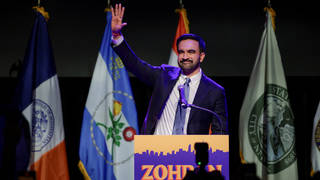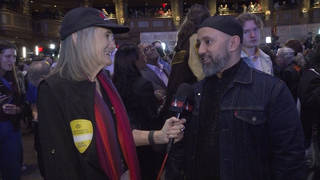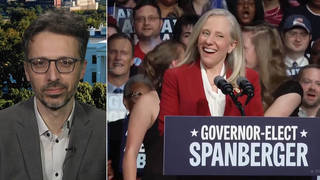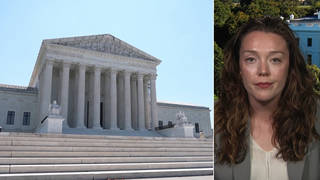
Topics
Guests
- Ruy Teixeiradirector of the Politics and Public Opinion Program at the Economic Policy Institute, and author of The Disappearing American Voter.
- Frances Fox Pivenpolitical scientist at the Graduate Center of the City University of New York and author of Why Americans Don’t Vote.
In recent days, pundits and pollsters have asserted that today will see one of the lowest voter turnouts in U.S. history. In recent years, more and more Americans have concluded that their votes don’t matter. This lack of voter participation raises serious questions about the state of our democracy as we cross that bridge to the next century.
Transcript
AMY GOODMAN: You’re listening to Democracy Now!
More of us can vote today, but it’s likely fewer will. As many as 90 million eligible Americans may not vote, even though the percentage of Americans who are registered is the highest since 1968. The Committee for the Study of the American Electorate estimates the Motor Voter law helped increase the number of registered voters by 5 million. But clearly, pundits and pollsters have been asserting in these last few days that today will see one of the lowest voter turnouts in U.S. history. In recent years, more and more Americans have concluded that their votes don’t matter. This lack of voter participation raises serious questions about the state of our democracy as we cross that bridge to the next century.
Joining us now is my co-host Juan González. He is a columnist with the New York Daily News.
Welcome, Juan.
JUAN GONZÁLEZ: Good morning, Amy.
AMY GOODMAN: And have you voted yet?
JUAN GONZÁLEZ: Yes, I have already.
AMY GOODMAN: Very good. I did my absentee voting on Sunday. We’re also joined in our studio by Ruy Teixeira. He is of the Economic Policy Institute and author of The Disappearing American Voter. We’re also joined by Frances Fox Piven. She’s a political scientist at the Graduate Center of the City University of New York and author of Why Americans Don’t Vote.
Well, tell us, Ruy Teixeira. Why don’t people vote?
RUY TEIXEIRA: Well, in the United States, there are basically a couple of reasons why people might not vote. One is that they find the whole process too onerous, too difficult. And that’s one thing at least we’ve made some progress toward addressing with the Motor Voter National Voter Registration Act. The other reason is that, for various and sundry reasons, voters in the United States tend to have — they seem to feel less motivated, less connected to politics than they do in a lot of other countries. And we may see a lot of that in this election. I have a feeling, judging from the polling data and other data, that people aren’t feeling particularly excited about this campaign or particularly connected to the political issues that are involved. And I think they may follow that through by not showing up today.
AMY GOODMAN: Frances Fox Piven, what’s your assessment of the feeling of American people today?
FRANCES FOX PIVEN: Well, I agree with Ruy that there’s a kind of complex interplay between the difficulties that have been placed in the way of voting by sort of the politics of American history and what Ruy calls the motivation of the voters. But I think that that’s better understood — this lax, low motivation is better understood as a reflection of the character of our electoral politics, when we have a presidential race that is clearly not competitive — Clinton has been ahead in the polls for a very long time — on the one hand, and, on the other hand, campaigns, campaign slogans, campaign advertising, that addresses issues that are not very important to Americans, the American people. And, you know, you began this segment by talking about the campaign finance corruption in connection with the Indonesian money that came from the Riadys. The significance of that kind of corruption is not only to people’s sense the system is scandal-ridden, but that the penetration of money means that many of the most important issues don’t get raised by either of the political parties. And that affects motivation.
JUAN GONZÁLEZ: Well, Frances, in your book — I remember reviewing it several years ago when it came out — there seemed to be, one, a lot of analysis of the class breakdown of nonparticipation, that, clearly, that it seems to — seemed to increase, at least in previous years, among working people and among less educated Americans. Have you begun to see any change in recent years? Certainly, I know that the Hispanic registration and voting rate will probably be higher this year, and African Americans have tended to vote more in recent years. Do you see any change? Is the disaffection now greater in the middle classes than it is, let’s say, among working people?
FRANCES FOX PIVEN: Well, we’re going to find that out, I think, in this election. The broader pattern of change seems to me to have been that during the 1960s, when civil rights — late 1960s, when civil rights issues and civil rights victories were very prominent, turnout rose among African Americans, and then it tended to fall back again. So, issues do matter. And, of course, in the 1960s, we also had the monumental achievement of the Voting Rights Act, which eliminated some of the barriers that had been put in the way of voting, particularly in the Southern states, where those barriers affected African Americans. So, literacy tests were gone, for example. So, there isn’t a long-term trend that is visible, excepting that as turnout falls — and it has fallen in the last 30 years — the people who tend to be most affected by that are people with lower incomes. And it’s worth pointing out that the class pattern in turnout, where those who are more affluent are much more likely to turn out, those who have less income are less likely, and the less income they have, the less likely they are to turn out, that that is directly paralleled by a class pattern in partisan preference, so that you see — and this has been true for some time, but it’s most remarkable, it seems to me, in this election, that the higher income people have, the more likely they are to be Republican. So, this skew in the pattern of turnout and its causes in procedural barriers and in party appeals is of enormous significance in election outcomes.
JUAN GONZÁLEZ: Well, Ruy Teixeira, what about the obstacles? Clearly, in most other countries that I’m familiar with, Election Day is usually a holiday, or it’s usually done on a weekend, whereas in this country the fact that most people have to work and that there isn’t that total attention of the whole nation to the election process could have quite a bit to do with the turnout, wouldn’t it? Especially given the fact that Americans increasingly have had to go to work in two-parent families rather than one, so that everybody’s working who can, and that creates even more difficulty in terms of being able to get out to the polls, to pay the attention you need to to the electoral process. Do you see this as a major obstacle to greater voter participation?
RUY TEIXEIRA: It may be an obstacle of some kind. Political scientists who have studied this question generally tend to think that the issue, an Election Day holiday, is probably not a big one. In other words, if it does have a depressing effect on turnout in the U.S., it’s probably a small effect rather than a large effect. For example, if it was a holiday, maybe a lot of people would just go off and have a picnic or hang out instead of voting. It’s hard to construct the argument that shows that it would necessarily produce a large increase in turnout. And if you try to study it from a kind of quantitative or statistical standpoint, it’s hard to see the relationship as being a big one.
AMY GOODMAN: You know, Juan and I have both been covering Haiti for a while, and I was down for the election of René Préval, who followed Jean-Bertrand Aristide. And there, the National Democratic Institute was, and the Republicans’ equivalent was down there. But the U.S. government was objecting to the fact that they couldn’t get — that they had placed obstacles in the way of people voting, because, in fact, only 90% of Haitians were expected to go to the polls and were registered. Compare that to what we have here. Ruy Teixeira, can you talk about how the U.S. compares in the world with the number of people who come out to vote?
RUY TEIXEIRA: OK. If you figure a turnout on the basis of the eligible population as opposed to those registered, because registration is part of the sort of voting system in our country — so, for example, if you look at it in terms of voting-age population, which is a good sort of way to compare most countries, because everybody’s got a voting age — we are basically pretty much at the bottom of the — especially of the advanced democracies, advanced industrial democracies. Switzerland sometimes beats us out for the cellar. But, basically, the international turnout average is probably close to about 80%. And in the last three presidential elections, we’d average about 53%.
AMY GOODMAN: So, can you —
RUY TEIXEIRA: So we’re pretty far below.
AMY GOODMAN: Can you actually call this a democracy? I mean, you’re talking about President Clinton elected last time with a little over a quarter of the vote?
RUY TEIXEIRA: Well, I guess — I mean, I don’t think this is the most desirable situation, but I guess I don’t think it necessarily calls our status as a democracy into question, particularly if you essentially — it is possible to simulate what the election results would look like if more people showed up or if everybody showed up. And, by and large, you know, particularly on the level of a presidential election or even a House election, the lack — the sort of relative prevalence of nonvoting doesn’t really necessarily affect the outcome terribly much. In other words, if you had 80% turnout instead of 50% turnout in today’s presidential election, in all likelihood the results wouldn’t look that different. Nor would they have in 1992 or 1988 or most other prominent elections that you can think of. So, I mean, basically, what our elections are like in this country is they’re sort of a poll. We’re essentially polling the electorate, and we have a sample, but it’s sort of a biased sample, class biased, as Frances was talking about. But it’s not enough of a bias to seriously distort the top line, at least in terms of the outcome.
FRANCES FOX PIVEN: Except sometimes.
JUAN GONZÁLEZ: In other words, what you’re saying, though, is that —
RUY TEIXEIRA: Occasionally.
JUAN GONZÁLEZ: — that if 90% of working people voted, and only 40% or 50% of middle- and upper-class people voted, that you’d still have the same results?
*FRANCES FOX PIVEN: Well, I don’t think that that’s true. It’s sometimes true. But in certain critical elections, there’s been a marked disparity between the results that would have occurred if the nonvoters had voted and the results that actually did occur. There was a big disparity in 1980. In 1994, when the Gingrich Congress was elected, there was a big disparity. And even in those elections where the difference between voters and nonvoters narrows or even disappears, one has to worry about the data because there is a kind of bandwagon effect, so that people who don’t vote, asked after the election who they would have voted for, tend to vote for the winner, you know, join the crowd. But so, that’s one. But some elections, even that doesn’t happen. Even that isn’t sufficient to obscure the significant gap between the results that would occur if everyone voted and if only those who turned out — the actual results that are produced by the turnout.
But there’s another part of that that’s very important. And that is that politicians and parties, they know who’s going to turn out. They have the data. And they craft their appeals and their programs to take account of who customarily turns out, so that those who don’t turn out, in a sense, get marginalized from the political system. They get isolated from the dialogue. They don’t have the opportunity to, at least symbolically, interact with the political program, with the political agenda. They are obliterated from politics. And that changes the way they think about politics, that it muffles the way they think about politics.
JUAN GONZÁLEZ: What about this on a deeper level, the whole issue of whether just even the emphasis on the vote as symptomatic of a healthy democratic process? To what degree has the mass media, the rise especially of television in the last 40, 50 years, reduced more and more the average American to a viewer of the political process rather than a participant and affected turnout, in the view of either — or, both of you?
FRANCES FOX PIVEN: Well, it wasn’t so great in the past. I mean, we are always in danger because we think that things are bad now, creating a mythical golden age.
But there are a couple of changes that television is clearly responsible for. One is that money is more important than ever to the campaigners, to the candidates and the parties. So, the reliance on television has sort of sucked all this money into the campaign. And, of course, those who give the money have influence on the candidates.
Another sense in which the reliance on television is important is that when the campaign is conducted entirely through the mass media, then — and there are no foot soldiers around, the people who used to go door to door, the precinct captains and so forth — and who’s even seen a button in this campaign? Nobody gives out buttons. But not only is it that there’s no sort of hands-on, direct, face-to-face contact with the campaign, which is meaningful to some people, but there is no one who, in a sense, helps prospective voters cope with the administrative barriers that are put in the way of voting, like voter registration, which is why Motor Voter is now so important, because there aren’t these hordes of campaign workers who used to help people register to vote. No one helps them now, and therefore it’s more important than ever that we have an automatic process for taking care of these procedures.
AMY GOODMAN: Ruy Teixeira, let’s give you the last word, as we wrap up. And adding to that question about is TV disempowering, the whole emphasis on polls rather than on issues?
RUY TEIXEIRA: Yeah, I think there’s truth to that. If you look at the kinds of things that sort of correlate with nonvoting, a lot of it has to do with the sense of not being connected to politics, not following politics, not knowing much about politics. And it’s not hard to see the possible connection between that and the way campaigns are currently run today. In a sense, the media are now the intermediaries between the average citizen and the politicians in the government. And I don’t think that’s necessarily adequate to really involve people in politics and make them feel connected to it. So, since people kind of tune out the process, partly because their only connection to it is through the media and through the polls, they wind up not voting. And how to correct that, I think, is a difficult question. The Motor Voter things is now in place. It’s been implemented in a lot of places. And yet, we may find — in this election, we have, you know, perhaps a record-low turnout, probably one below 1992, despite the registration reform changes that have taken place. So, it’s not clear to me that Motor Voter is going to really make a huge dent in this voter motivation problem, and that we may have to do some more creative thinking.
AMY GOODMAN: Well, it’s clearly going to have to be people doing the creative thinking as opposed to politicians, since they seem to be quite satisfied, particularly incumbents. They’re there because of exactly the status quo. I want to thank you very much for joining us, Ruy Teixeira. He is author of The Disappearing American Voter, and he works over at the Economic Policy Institute here in Washington, D.C. And we’ve been joined by professor Frances Fox Piven, who is a political scientist at the Graduate Center of the City University of New York and author of Why Americans Don’t Vote. I’m Amy Goodman, with Juan González. We’ll be back talking about the Christian Coalition’s voter guides and others. Stay with us.












Media Options